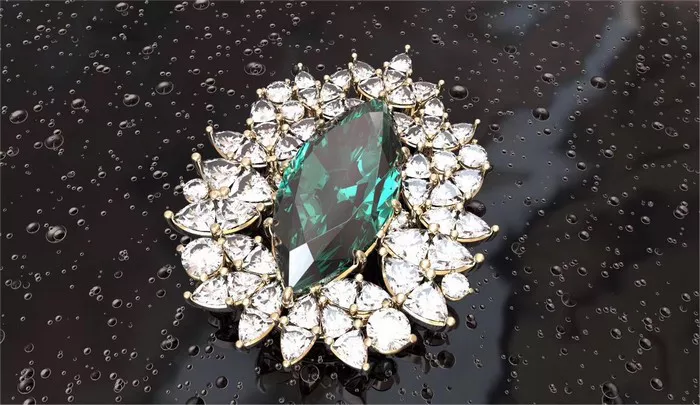Emeralds have captivated humanity for centuries with their mesmerizing green hue and inherent allure. In this comprehensive guide, we delve into what makes the best emeralds, exploring their quality factors, origins, historical significance, treatments, buying considerations, care tips, and investment potential.
Emerald Quality Factors
When assessing emerald quality, experts consider the four Cs: color, clarity, cut, and carat weight.
Color: The most crucial factor in evaluating an emerald is its color. The finest emeralds exhibit a vivid, saturated green hue with a hint of blue. Stones with a pure green color command the highest prices.
Clarity: Unlike diamonds, emeralds often have inclusions, known as jardin (French for garden). These inclusions are acceptable as long as they don’t detract from the stone’s beauty or compromise its durability.
Cut: A well-cut emerald maximizes its color and minimizes the visibility of inclusions. Popular cuts for emeralds include the emerald cut (rectangular with truncated corners) and the cushion cut (square or rectangular with rounded corners).
Carat Weight: Emeralds are typically cut in smaller sizes due to their rarity and the challenges posed by their natural inclusions. Larger emeralds with exceptional color and clarity command premium prices.
Each of these factors contributes to the overall beauty, value, and appearance of an emerald.
Origin of Emeralds
The best emeralds are sourced from a few select regions known for producing top-quality stones. These include:
Colombia: Colombian emeralds are renowned for their rich, deep green color and exceptional clarity. The country’s Muzo and Chivor mines yield some of the world’s finest emeralds.
Zambia: Zambian emeralds are prized for their bluish-green hues and good transparency. The Kagem mine in Zambia is a significant source of high-quality emeralds.
Brazil: Brazilian emeralds are known for their unique bluish-green coloration and excellent transparency. The Belmont mine in Brazil produces emeralds of exceptional beauty.
The origin of an emerald can significantly influence its quality, color, and price, with Colombian emeralds often commanding the highest premiums due to their historical reputation and unique characteristics.
Historical and Cultural Significance
Emeralds have a rich history intertwined with various cultures and civilizations. In ancient times, emeralds were associated with fertility, rebirth, and protection. They were often worn by rulers and royalty as symbols of power and prosperity.
In Egyptian mythology, emeralds were linked to the goddess Isis and believed to bring fertility and eternal youth. The Incas and Aztecs of South America considered emeralds sacred and used them in religious ceremonies.
Throughout history, emeralds have been prized for their beauty and believed mystical properties, making them highly sought-after and valuable gemstones.
Emerald Treatments
Many emeralds undergo treatments to enhance their appearance and durability. The most common treatment is oiling, where emeralds are immersed in oils to fill surface-reaching fractures and improve clarity. This treatment can enhance the gem’s beauty but may require periodic re-oiling to maintain its appearance.
Other treatments include filling with resin or using lasers to remove inclusions. It’s essential for buyers to inquire about any treatments an emerald has undergone and ensure they understand how these treatments may affect the gem’s long-term care and durability.
Buying Guide
When purchasing emeralds, consider the following factors to ensure you’re getting a quality gemstone:
Color: Look for emeralds with a vibrant, evenly distributed green color. Avoid stones with yellowish or brownish tints.
Clarity: While some inclusions are acceptable, avoid emeralds with significant fractures or cloudiness that detracts from their beauty.
Cut: Choose a well-proportioned cut that maximizes the stone’s color and minimizes the visibility of inclusions.
Origin: Consider the origin of the emerald, as stones from certain regions may command higher prices due to their reputation for quality.
Certification: Purchase emeralds from reputable sellers who provide gemological certificates verifying the stone’s authenticity and quality.
Budget: Set a budget based on the quality and size of emerald you desire, keeping in mind that high-quality emeralds can be significant investments.
By following these guidelines, you can select an emerald that meets your preferences and budget while ensuring its authenticity and quality.
Care and Maintenance
To preserve the beauty of your emerald over time, follow these care tips:
Avoid Harsh Chemicals: Keep emeralds away from chemicals such as household cleaners and perfumes, as they can damage the gemstone.
Gentle Cleaning: Clean emeralds with a soft cloth and mild soapy water. Avoid ultrasonic cleaners or steam cleaning, which can be too harsh for emeralds.
Storage: Store emeralds separately from other jewelry to prevent scratches. Consider using a jewelry box with individual compartments or soft pouches.
Professional Inspection: Periodically have your emeralds inspected by a professional jeweler to check for any damage or loose settings.
With proper care and maintenance, emeralds can retain their beauty and value for generations.
Investment Potential
Emeralds, especially those of exceptional quality and rarity, can be valuable investments. Factors that contribute to their investment potential include:
Rarity: High-quality emeralds are rare, especially those with intense, saturated green colors and few inclusions.
Market Demand: The demand for emeralds, particularly from collectors and connoisseurs, can influence their value over time.
Historical Significance: Emeralds with historical provenance or cultural significance may command higher prices among collectors.
Quality: Emeralds with exceptional color, clarity, and origin tend to appreciate in value more than lower-quality stones.
However, like any investment, it’s essential to research thoroughly, seek expert advice, and purchase from reputable sources to ensure you’re making a sound investment decision.
In conclusion, emeralds are not just exquisite gemstones; they are symbols of beauty, history, and cultural significance. Whether you’re purchasing an emerald for its aesthetic appeal or considering it as an investment, understanding its quality factors, origins, treatments, and care requirements is essential to making an informed decision and enjoying your emerald for years to come.


